Tasty, juicy filling with soft, fluffy wrappers, homemade bao buns are super comforting! This guide offers tips and tricks to ensure a fail-proof cooking experience.

Popular as street food and an everyday family dish in China, steamed bao buns (Baozi, 包子) is one of the foods I really enjoy cooking. They are not difficult to make but it can be very tricky to get them right, especially when it comes to making a nice wrapper which rises properly, has a smooth look and a soft, fluffy texture. Today, I’m sharing all the knowledge I’ve gained through trial and error over the years.
Which type of flour for bao buns?
Which type of flour shall I use to make bao buns? My answer to this FAQ is all types of wheat flour works (regardless of the gluten level). However, you may wish to choose a particular type of flour to achieve a certain look/texture.
Do you like them fluffy and less chewy? Then use flour which has a medium to low gluten level. Check the nutrition label on your flour package. The protein content should be under 11g per 100g flour. As far as I know, common all-purpose flour in the UK and the US is within this range. It’s the type I use most frequently for bao buns.
Cake flour has 8-9g protein in 100g flour, so it delivers the least chewy texture. If like me, you don’t have easy access to cake flour, there is a simple substitute: Mix all-purpose flour with cornstarch (ratio: 5:1 by weight). Sift before using.
Another note: as yeast is used as a raising agent in bao buns, do not use self-raising cake flour which is commonly available in the UK.
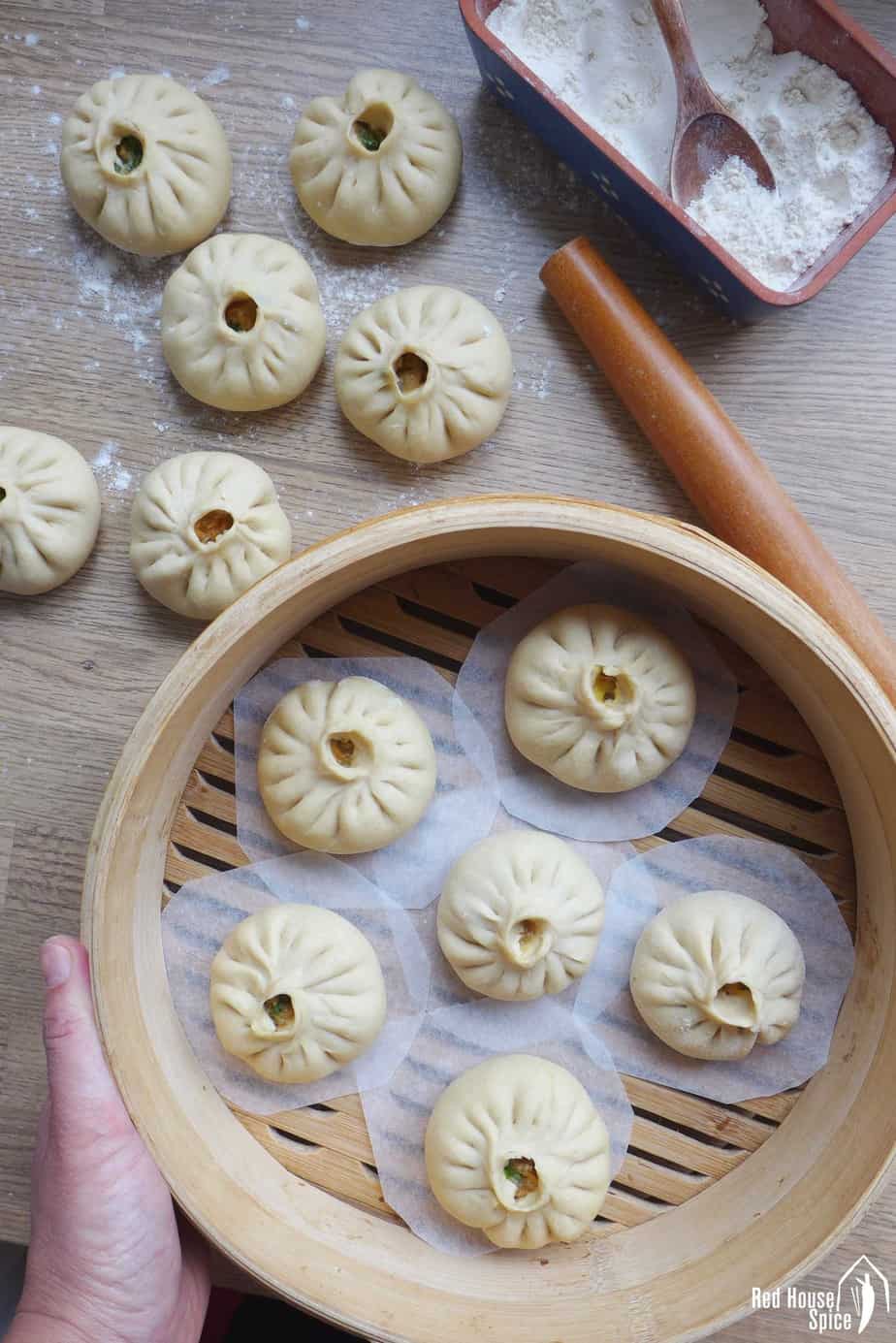
Is special bao flour better?
Flour specifically labeled as Bao bun flour/Mantou flour is available in Chinese/Asian shops. It has a low gluten level (around 8g protein in 100g flour) so it’s good for producing fluffy Bao. However, personally I don’t like it as it’s heavily bleached and processed (that’s why it produces a whiter finished look). I’ve tried several brands of bao flour and I find them lacking in natural wheat flavour.
How to make the dough?
Unlike dumpling (Jiaozi) dough which is made from water and flour, bao buns call for the leavened dough which involves the use of yeast. The wrapper rises during the process of steaming.
My recipe for Bao bun dough requires five ingredients: all-purpose flour; dried yeast; sugar; cooking oil, and lukewarm water.
- The flour & liquid (water + oil) ratio is 2:1 by weight. It may vary a little depending on the type and the brand of your flour.
- The water & oil ratio is 10:1 by weight. It’s better to choose the cooking oil which doesn’t have a strong taste (eg. rapeseeds, sunflower, canola, vegetable, etc.).
- For every 500g of flour, you will need 2 teaspoons of dried yeast. Add the same amount of sugar or a little less (but not more).
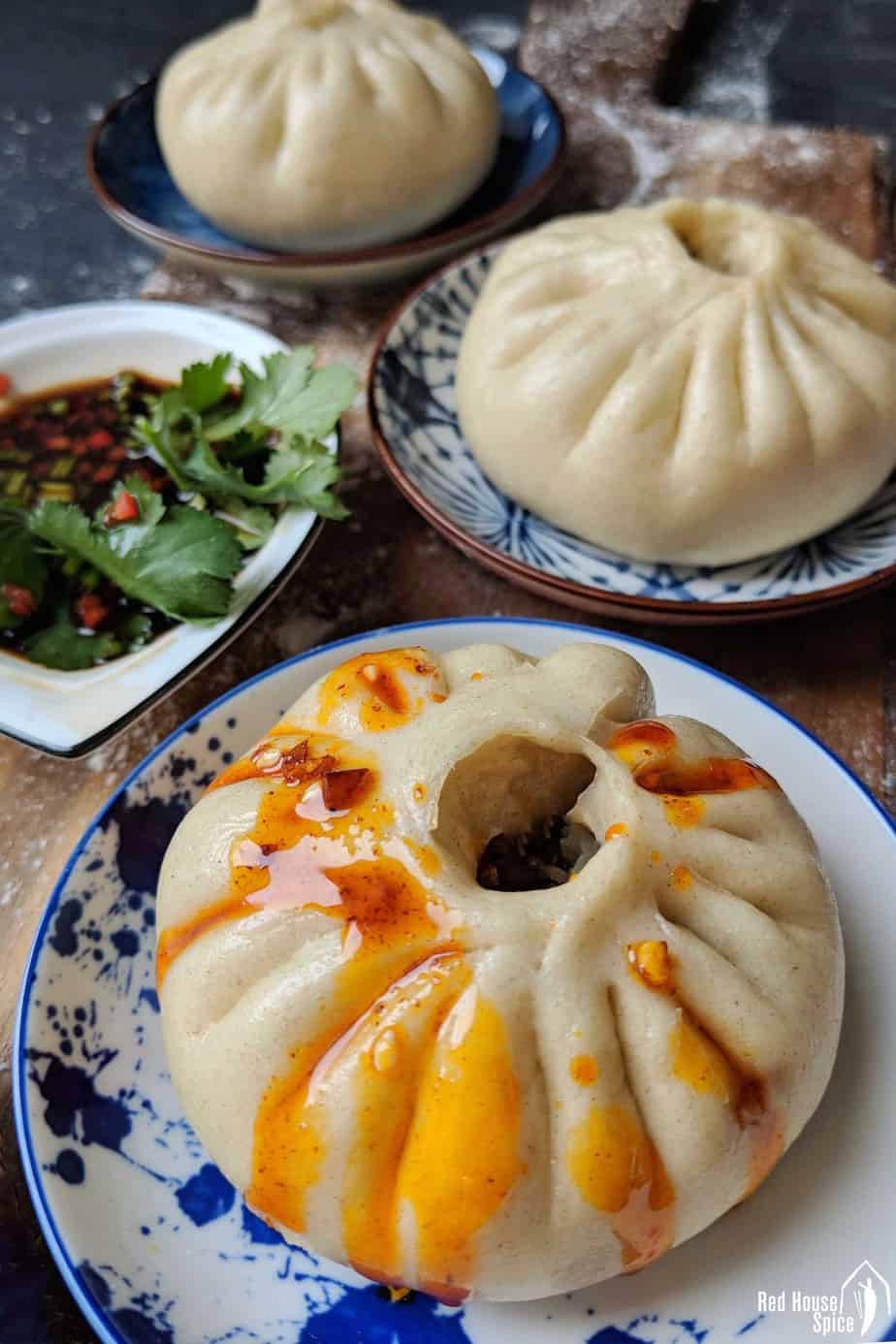
Why is kneading important?
Everyone loves a bao bun with smooth, even skin. Unfortunately, homemade ones can easily end up with a pot-marked look. The well-kneaded dough will create even air bubbles inside the dough and therefore lead to a smoother appearance after steaming.
I’ve done a test with my six-year-old daughter. We kneaded two identical pieces of dough then rested and steamed them in the exact same way. Obviously she has much less strength and skill in kneading. So her buns had a much rougher look. Another surprising finding was that extended kneading will lighten the colour of your dough.
Here are my tips on kneading:
- You may use your hands or a stand mixer with a dough hook. Knead until the dough is very smooth.
- For me, the best practice is to initially combine the dough in the stand mixer for 5 minutes or so, then knead with hands to finish.
- After the dough has risen and before shaping the buns, you need to knead the dough again until it returns to its original size and the smooth look.

How long to rest the dough?
Fermentation takes place when you leave your yeast dough to rest. As yeast is very sensitive to temperature, the required resting time varies a lot. To double the size of the dough, it can take as little as 40 minutes if the room temperature is high (and/or if the dough is small in size), or up to 1.5 hours if it’s cold.
To accelerate this process, you can:
- Place the dough bowl in a warm room/area. For example, near a radiator or a preheated oven.
- Heat up a glass of water in the microwave then put your dough bowl inside (keep the glass in). Shut the microwave door.
- Turn on your empty drier for 2 minutes then place the dough bowl inside (I learned this trick from food blogger Nagi).
- Cover your bowl with a damp cloth as humidity also affects fermentation.
Leave the dough to rise until its size doubles. Then knead again to remove any bubbles trapped inside. After shaping the dough into individual Bao, leave them to rise a second time before steaming, about 15 minutes this time.
How to avoid bao bun collapsing?
If you have tried to cook bao buns before, you probably know how tricky it can be. The most common problem is that the wrappers collapse/wrinkle/harden after steaming. I believe many of you would hold your breath (or cross your finger) the moment you remove the steamer lid.
The inconsistency of the cooked wrappers used to drive me mad too. So I’ve conducted numerous trials and kitchen experiments to overcome these problems. Now I’m happy to share my findings with you.
- First of all, allow me to clarify a myth. Many recipes suggest that you should wait for 5 minutes before you uncover the steamer. This does not prevent collapsing at all. I always immediately remove the lid after I turn off the heat (as my parents and restaurant chefs do), my bao buns don’t change their look if the dough has been prepared properly.
- Make sure you include a little sugar and cooking oil when making the dough. Sugar helps to activate the yeast, therefore, guarantee a good rise. Oil reduces the transmission of the moisture from the filling into the dough, therefore make collapsing less likely.
- As I mentioned above, kneading affects the appearance of bao buns. Extend the kneading time and make sure the dough is perfectly smooth before shaping.
- It’s CRUCIAL to allow enough resting time during the dough fermentation process (two times as I explained above).
- Don’t roll your wrapper too thin (especially the middle part) otherwise the moisture from the filling might leak into the wrapper making it soggy.
- Start cooking with cold water in your steamer. The gentle rise in temperature helps the dough grow smoothly. Turn the heat down when water starts boiling. Count cooking time from this moment. I suggest no less than 15 minutes.
Make a tasty and juicy filling
I use pork and carrots as the main ingredients in this recipe. Onion and coriander are added to boost the flavour.
- Add water/stock to the pork will produce a juicy filling. You can find more tips on this topic in my post “How to make great dumpling fillings”.
- Briefly stir fry carrot and onion in a little oil. This will enhance their flavour and give the filling a soft texture.
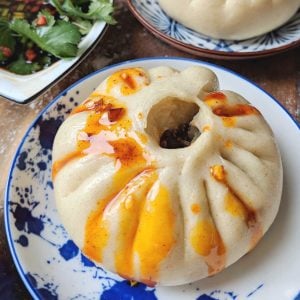
Steamed bao buns (包子), a complete guide
Ingredients
For the dough
- 300 g all-purpose flour - or cake flour, see note 1
- 1 teaspoon dried yeast
- 1 teaspoon sugar
- 1 tablespoon cooking oil - see note 2
- 140 ml lukewarm water - see note 3
For the filling
- 150 g minced pork
- 1 teaspoon light soy sauce
- 1 teaspoon oyster sauce
- 1 pinch ground Sichuan pepper - or Chinese five-spice powder
- ¼ teaspoon salt
- 4 tablespoon water - or unsalted stock
- 1 tablespoon cooking oil
- 150 g carrot - grated
- 1 small onion - finely chopped
- 2 tablespoon coriander - finely chopped
Instructions
Prepare the dough
- Mix flour, yeast, sugar and oil in a bowl. Pour in water little by little while mixing.
- Combine and knead with your hands until a very smooth dough forms (see note 4).
- Cover the bowl with a damp tea towel and leave to rise in a warm place until doubled in size (It will take between 40 minutes to 1.5 hours depending on the room temperature).
Mix the filling
- Put pork, soy sauce, oyster sauce, salt and Sichuan pepper/Chinese five-spice in a mixing bowl.
- Swirl constantly while gradually adding water/stock until no more liquid can be seen.
- Brief stir fry grated carrot and onion in oil until softened. Add to the pork along with chopped coriander.
Shape the buns (Please refer to the video below)
- Knead the dough until it goes back to its original size.
- Divide it into 12 equal portions. Roll each piece into a disk-like wrapper.
- Place some filling in the middle of a wrapper then fold into a bao shape.
- Leave all the assembled buns to rest for another 15 minutes or so.
Steam the buns
- Place the buns (with parchment paper underneath each one) in the steamer basket (see note 5). Leave 2cm space between the buns and the side of the steamer.
- Start cooking with cold water over a high heat. Turn the heat down to medium-low when the water starts boiling.
- Cook for 15-18 minutes.
Serving with a dipping sauce
- Serve them warm, on their own or with some dipping sauce (find inspirations in my post Six dumpling sauces).
Storage & reheat
- You can freeze cooked buns. Leave to defrost in the fridge then steam for 8 minutes to warm up, or steam for 15 minutes without defrosting.
Video
NOTES
NUTRITION
NUTRITION DISCLOSURE: Nutritional information on this website is provided as a courtesy to readers. It should be considered estimates. Please use your own brand nutritional values or your preferred nutrition calculator to double check against our estimates.


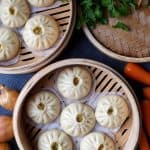
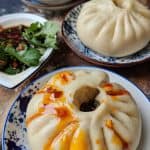
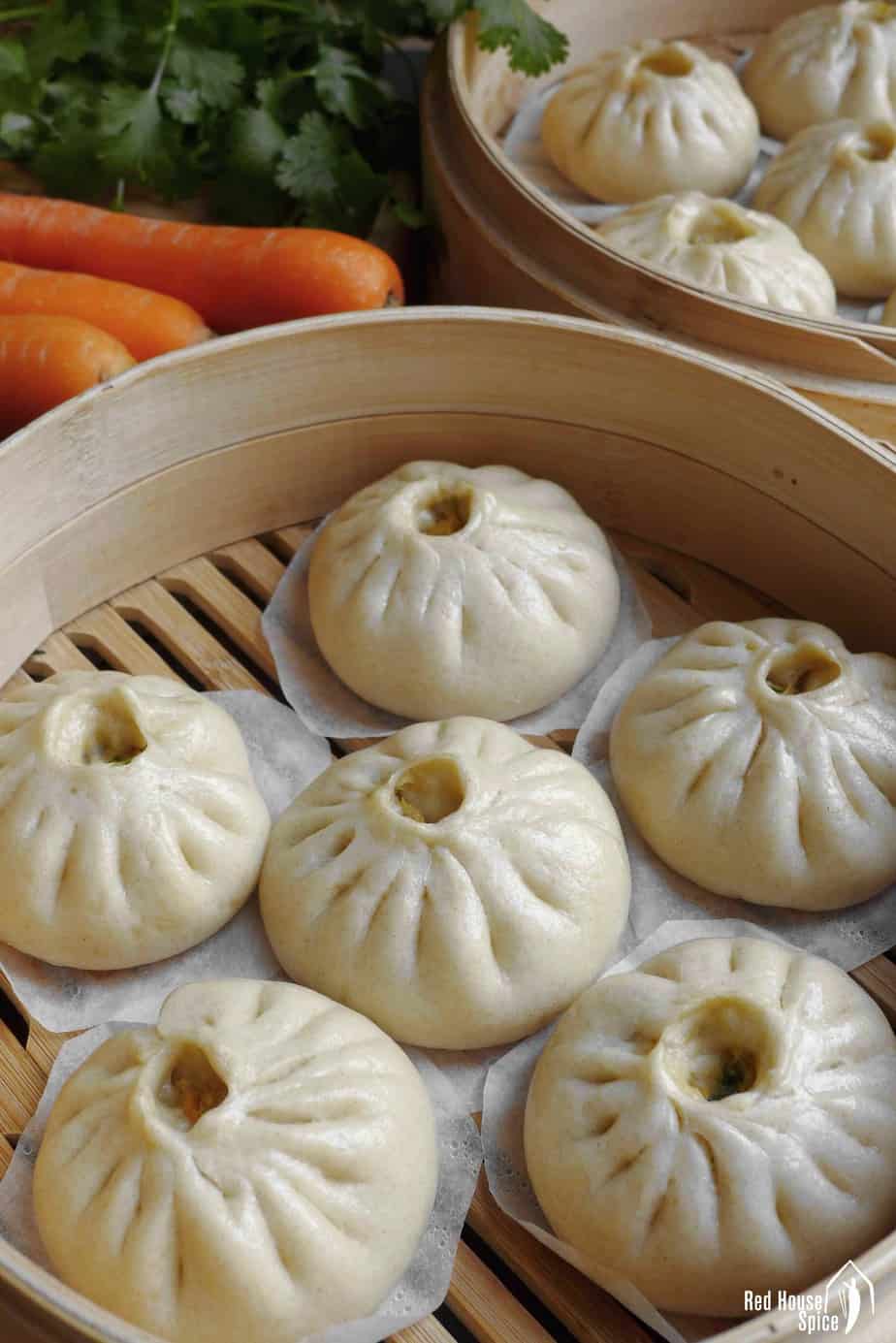
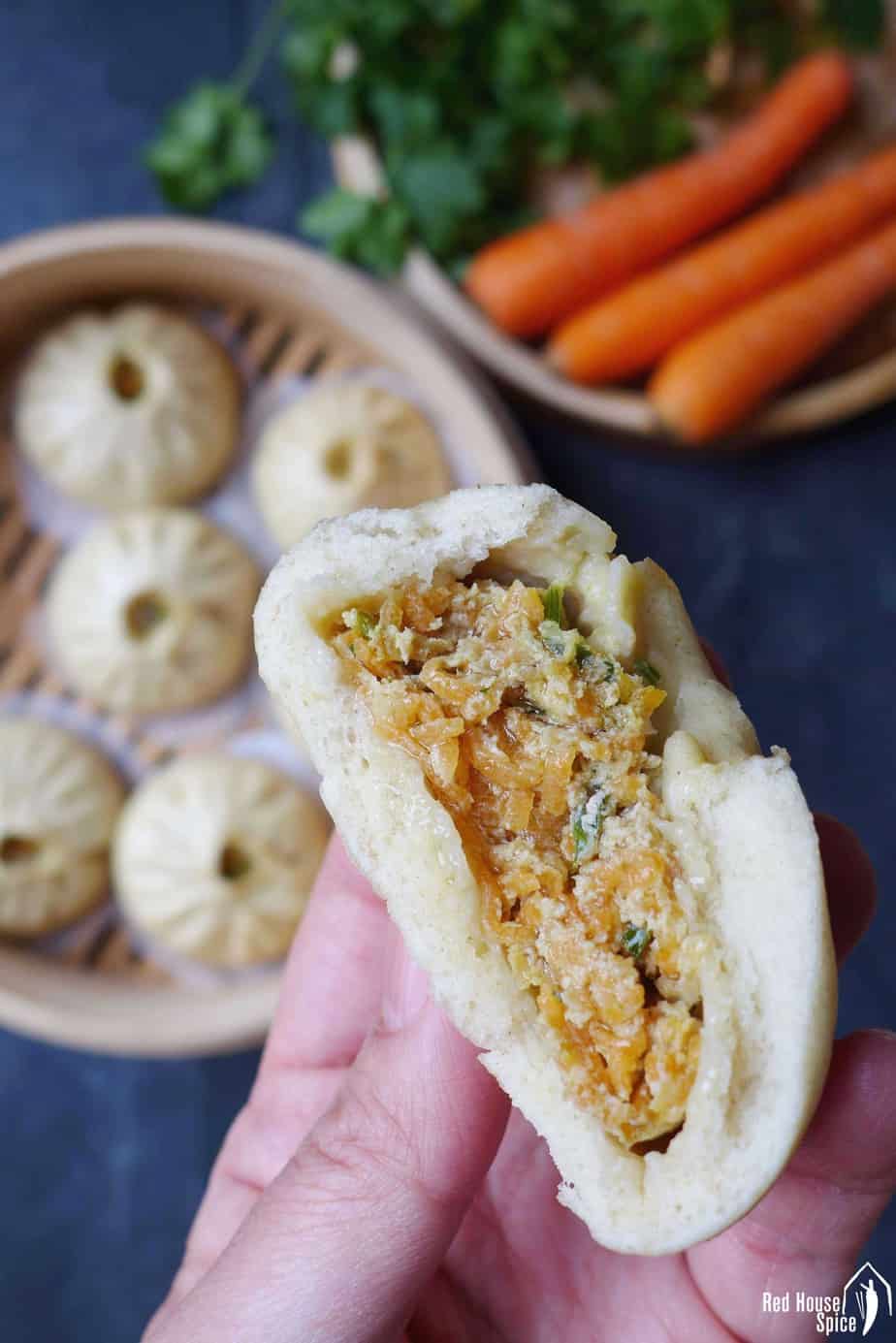
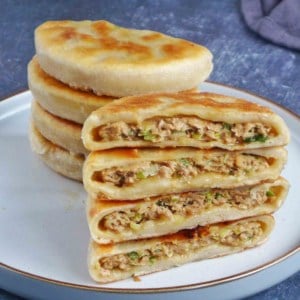
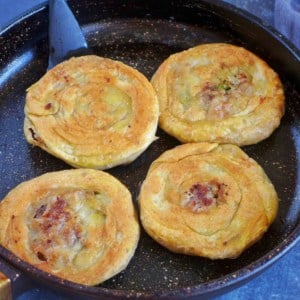
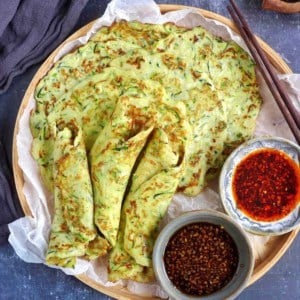
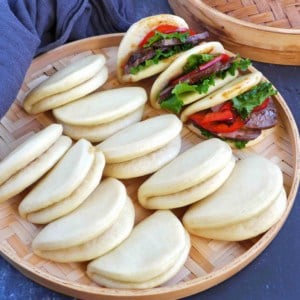
Thank you so much for this extensive post! A question: have you ever dried freezing baozi and defrost before cooking? Or store them in the fridge, if so for how long? I’d like to make them for a christmas family dinner, but will not be able to prepare all quantities needed the same day.
Thank you so much
Claudia
Hi Claudia! Since this is a yeast dough, I don’t recommend you freeze uncooked bao. As I mentioned in the recipe, cook them first and then freeze once they cool down.
You may leave them to defrost in the fridge then steam to reheat, or directly steam frozen ones for 10-15 mins. They will be just as good as the freshly cooked ones.
Hi,
Thanks for the indepth detail on bao making….one question though…why such a short second ferment of only 15 mins? Would the yeast have had enough time to do its work? Have you tried the single ferment method? How are the results as compared to double ferment?
15 mins are enough for the 2nd proofing as long as the 1st proofing is properly done. If you’d like an easier approach, try my dough recipe introduced in the post on Char Siu Bao which uses yeast + baking powder method. You’d only need 30 mins proofing for once.
I tried the bao dough recipe and used a vegetarian curry filling instead. The bao dough is easy, straightforward and uses everyday ingredients. Also love the very comprehensive explanation about types of flour, which was daunting to me before I stumbled upon Wei’s blog. Bao dough is a winner, thank you so much!
Wonderful to hear that Ashie! Once you’ve mastered the dough recipe, you can fill it with anything you like. Vegetarian curry…Sounds delicious!
I used the bao bun flour from the Chinese store. The recipe on the packet did not call for any oil; only the flour, provided yeast, sugar and water.
The end product is OK, but the exterior of the bun is a little tough. Do you know how to prevent that?
Thanks!
Did you follow my recipe or the one on the flour package? It’s fine to exclude oil if you wish as it’s not an indispensable ingredient.
The outer layer of bao buns is supposed to have a slightly chewy texture but it shouldn’t be unpleasantly tough when freshly steamed. It becomes tougher once cooled. Reheating in the steamer would bring them back to the original texture.
for the filling, is the minced pork a bacon or a ground pork?
Minced pork means ground pork.
Planning on making bao 2 days ahead due to the long wait times. Can I freeze the formed buns after I make them and then steam them after?
It’s best to cook them and then freeze once they cool down. Steam for 10 mins or so before serving (no need to defrost).
What kind of steamer basket do you use?
They are bamboo steamer baskets shown in the images.
Just tried it out, and it worked out perfectly. Thank you for this great recipe!
Have you ever experimented with gluten free flours? I am allergic to wheat. I would love to get the texture and flavor correct.
Thank you,
Ginger
I’ve just had a test using gluten-free buckwheat flour and Xanthan gum. Unfortunately, I’d say it was a failure. Neither the taste nor the texture resembles regular steamed buns.
This recipe is amazing!! Just made it tonight and they tasted great and had a really nice fluffy texture. My pleating was extremely messy. But I’m definitely going to get better because I’m making them again. Going to experiment with some other yummy fillings! Thank you! I love how you outline the specifics and alternatives. It was very helpful!
So happy to hear you find my tips helpful!
Is there a reason your dough doesn’t include salt? I don’t know if it’s traditional or not, but salt should help improve the texture of the dough, prevent collapsing to an extent, and add flavor. The bulk ferment and proofing times would need to be adjusted as well.
Thanks for the information Conor! The traditional dough recipe for Bao buns doesn’t call for salt.